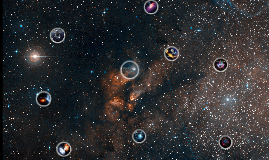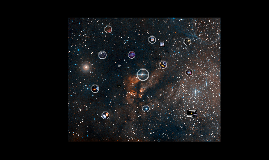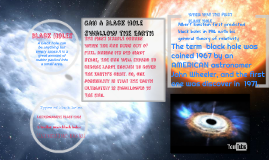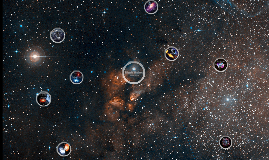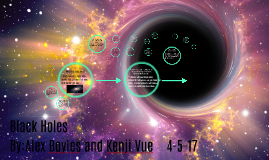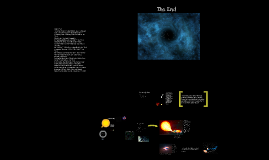Black Hole Presentation
Transcript: What is a Black Hole? This is not to say that Black Holes act like giant space vacuums, though. One can establish a stable orbit with a black hole as long as they hit the right velocity and angle. Around This Big! Stellar Mass Black Holes Not much is known as to how Supermassive Black Holes form. Works Cited "10 Interesting Facts About Black Holes - Astronomy Trek." 10 Interesting Facts About Black Holes - Astronomy Trek. Astronomy Trek, n.d. Web. 20 Jan. 2013. "Black Holes." National Geographic. Nationalgeographic.com, n.d. Web. 22 Jan. 2013. Freudenreich, Craig. "How Black Holes Work." HowStuffWorks. HowStuffWorks.com, n.d. Web. 17 Jan. 2013. Plait, Philip C. "10 Cool Facts about Black Holes!" Bad Astronomy. Slate.com, 30 Oct. 2008. Web. 22 Jan. 2013. Plait, Philip C. Death from the Skies!: These Are the Ways the World Will End--. New York: Viking Penguin, 2008. Print. "Primordial Black Holes." Black Holes. Florida State University, n.d. Web. 18 Jan. 2013. Melia, Fulvio. The Black Hole at the Center of Our Galaxy. Princeton: Princeton UP, 2003. Print Shipman, Harry L. Black Holes, Quasars, and the Universe. Boston, [MA: Houghton Mifflin, 1980. Print Kaufmann, William J. Black Holes and Warped Spacetime. San Francisco: W.H. Freeman, 1979. Print The jets shoot beams of plasma many lightyears out into space, and can even strike other solar systems. Black Holes They may have come from Stellar Black Holes gathering mass over time, or formed soon after the Big Bang occurred. The Black Hole's gravity would be so strong that its effect on your feet would be more powerful than that on your head, resulting in you getting stretched out into a thin strand. "Inside the event horizon of a black hole, there is no way out. There are no directions of space that point away from the singularity. Due to the curvature of spacetime within the event horizon, all the trajectories that would carry you away from the black hole now point into the past. Moving is of no use to you … because you cannot find a direction in which to point yourself. The singularity is all around you, in every direction you look. And it is getting closer." It is theorized that a Supermassive Black Hole lies at the center of our Milky Way Galaxy. Black Holes can orbit Stars. Sometimes without consequence, but other times the consequences are AWESOME Black Holes can also be very bright! Occasionally, a black hole will come across so much mass that it cannot absorb it all at one time. What forms then is called an "accretion disk." This is an artist's interpretation of a Black Hole Notice the Redshifting and Blueshifting of the matter. This is because the matter in many accretion disks moves so quickly that it affects the light around it! . Falling into a Black Hole would not be good times. First, you would be "Spaghettified" (the official scientific term). In order for a black hole to form, the star that is going supernova must be at least 25 times as massive as our sun. The leftovers of a supernova often form into small Nebulae. The edge of the back hole is called the "event horizon," which is the point where light can no longer escape the hole's gravity. The singularity is where all of the mass of the black hole lies. The rays shooting out of either side are called "Disk Jets." Astronomers are actually unsure as to why they manifest. They could be getting rid of extra momentum, or be caused by the extreme amounts of magnetism being created. The Cool Stuff If you managed to survive this (you wouldn't) and then make it into the Event Horizon of the Black Hole, things get really weird. Here's a quote from a NASA Scientist on the subject. So basically Black Holes can shoot giant laser beams at other things in space. The End Relentless Cosmic Forces Pictured here are several stars orbiting a Supermassive Black Hole. Supermassive Black Holes are Black Holes that have masses in the hundreds of thousands to BILLIONS of solar masses. Contrary to popular belief, black holes are not portals to other dimensions or shortcuts through the Universe to some unknown point. Those that formed right after the Big Bang are called "Primordial Black Holes." They were formed because of the extreme pressure and mass being released during the expansion event. After being given 14 Billion years to fly around the Universe, they had gathered ample mass to be called "Supermassive." The Weird Stuff This is a Red Supergiant, the biggest kinds of star known to mankind. They have the shortest lifespans of any other recorded stars, around 300,000 years to 1 million, which is miniscule when it comes to cosmic lifetimes. In short, a black hole is an extremely dense solar body which has an escape velocity that is larger than the speed of light. Black Holes happen when a mass cannot withstand its own gravity, and collapses. And that is VERY much in short. From here, the star could either eliminate its outer layers, or go supernova. In order to create a black hole, it must do the latter. In fact,






